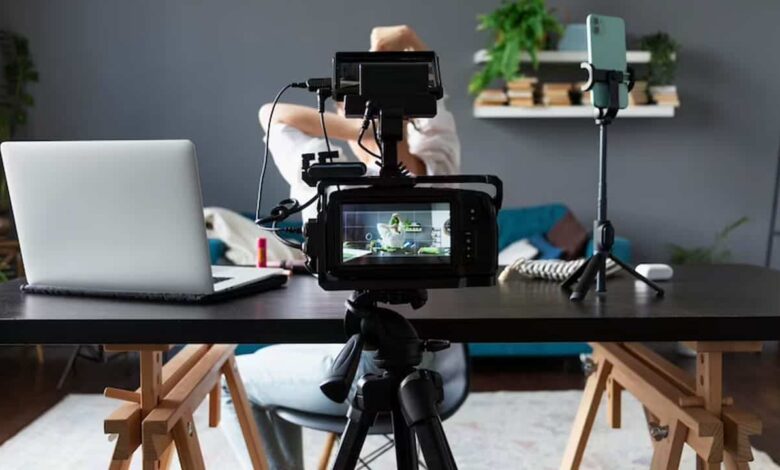Creator Economy Monetizes Skills and Passions

The traditional career path is no longer the sole route to success. A fundamental shift is underway, driven by the rise of The Creator Economy. This new paradigm empowers individuals to monetize their skills, passions, and content directly, bypassing traditional gatekeepers and corporations. From a single YouTube channel to a full-fledged digital business, creators are building empires on their own terms. This isn’t just a trend; it’s a profound transformation of work, entrepreneurship, and consumption. This article will take a deep dive into the key drivers of the Creator Economy, exploring the platforms and technologies that fuel its growth, the new business models it is pioneering, the challenges that creators face, and the immense impact it will have on the future of work and culture.
The Rise of the Individual

For decades, media consumption was a one-way street: a large corporation produced content, and the audience passively consumed it. The internet shattered this model, and the Creator Economy is the ultimate result of that disruption.
A. Democratization of Tools and Platforms
The most significant factor behind this revolution is the accessibility of tools and platforms. What was once the domain of professional studios and publishers is now available to anyone with a smartphone and an internet connection.
- Social Media as a Launchpad: Platforms like YouTube, Instagram, and TikTok provide a global stage for creators to share their work. They act as distribution channels, marketing engines, and community hubs, all in one.
- Affordable Production Technology: High-quality cameras, microphones, and editing software are no longer prohibitively expensive. This has lowered the barrier to entry, allowing anyone to produce professional-grade content.
- Monetization Gateways: Platforms are now equipped with built-in monetization tools, from ad revenue sharing and subscriptions to tipping features, allowing creators to earn a living directly from their audience.
This democratization has unlocked a wave of creative talent from all corners of the globe, giving a voice to a diverse range of perspectives and ideas.
B. A Desire for Authenticity and Connection
In an era of corporate-produced media, audiences are craving authenticity and a genuine connection. The Creator Economy provides just that.
- Building a Personal Brand: Creators are their own brand. Their audience follows them not just for their content but for their personality, values, and story. This builds a level of trust and loyalty that is difficult for traditional corporations to replicate.
- Direct Interaction: The relationship between a creator and their audience is a two-way street. Creators can interact directly with their community through comments, live streams, and Q&A sessions, fostering a sense of belonging and making their audience feel valued and heard.
- Niche Communities: The Creator Economy thrives on niche interests. Creators can build highly engaged communities around specific topics, no matter how obscure. This allows them to connect with a passionate, dedicated audience that is often overlooked by mainstream media.
The New Business Models
While advertising was the original form of monetization, creators are now diversifying their income with a portfolio of new business models, creating more stable and sustainable careers.
A. Direct-to-Consumer (D2C) Offerings
Creators are bypassing traditional retail and selling products directly to their audience. This model is incredibly powerful because the creator already has a built-in audience of potential customers.
- Digital Products: This is the most common form of D2C. Creators can sell e-books, online courses, digital art, presets for photo editing, or downloadable templates. The profit margins are high, and the products can be sold to a global audience with a single click.
- Merchandise and Physical Goods: Many creators, particularly those with a strong personal brand, are selling merchandise that features their logo or a catchphrase. Some are even launching full-fledged clothing lines, beauty products, or home goods.
- Paid Communities and Memberships: Platforms like Patreon and Substack allow creators to build a sustainable income through subscriptions. Their most dedicated fans can pay a monthly fee for exclusive content, access to a private community, or a more direct line of communication with the creator.
This D2C model gives creators more control over their income and their brand, reducing their reliance on the unpredictable nature of ad revenue.
B. The Power of Personal Brand as an Asset
In the Creator Economy, a strong personal brand is the most valuable asset. It is a form of social capital that can be leveraged for a wide range of opportunities.
- Brand Partnerships and Sponsorships: Companies are no longer just buying ad space on a website; they are partnering with creators whose audience aligns with their brand values. This “influencer marketing” is a powerful way for brands to reach a highly engaged and targeted audience.
- Speaking Engagements and Consulting: Experts in a particular niche can leverage their personal brand to secure paid speaking engagements, consulting gigs, and book deals.
- Affiliate Marketing: By recommending products and services they genuinely believe in, creators can earn a commission on every sale made through their unique link.
The Challenges of the Creator’s Journey

While the Creator Economy offers incredible opportunities, it is not without its significant challenges. The path to success is often difficult and filled with uncertainty.
A. Financial Instability and Burnout
Unlike a traditional job with a stable salary and benefits, a creator’s income can fluctuate wildly. This financial instability, combined with the pressure to constantly produce new content, can lead to a high rate of burnout.
- The Algorithm’s Whims: A creator’s income is often at the mercy of the algorithm. A change in a platform’s algorithm can drastically reduce a creator’s reach and revenue overnight, creating a sense of constant precarity.
- The “Always On” Culture: The pressure to be constantly engaging with an audience, creating new content, and managing a business can be overwhelming. Many creators struggle with work-life balance and the mental health toll of a hyper-connected career.
B. The Need for Diversified Skills
Being a creator requires a diverse skill set that goes far beyond just producing content. Creators must also be their own:
- Marketing Director: They are responsible for promoting their content, running ad campaigns, and managing their brand’s social media presence.
- Accountant: They must manage their finances, track expenses, and file taxes, often for multiple income streams.
- Community Manager: They must moderate comments, engage with their audience, and build a sense of community.
- Product Developer and Designer: Many creators are also responsible for designing and developing their own products, from e-books to merchandise.
The Future of Work and Culture
The Creator Economy is not just about a few famous influencers. It is a fundamental shift in how we think about work, and it will have a lasting impact on our society.
A. A New Standard for Work
The Creator Economy is challenging the traditional 9-to-5 model. It is a powerful example of a new, more flexible, and purpose-driven way of working. As more people see the success of creators, it will put pressure on traditional companies to offer more flexible work arrangements and to align their missions with their employees’ values.
B. The Democratization of Expertise
The Creator Economy is breaking down the old model of institutional expertise. Anyone with a passion and a platform can become an expert on a topic, from personal finance and home repair to cooking and coding. This democratized access to information and education is a powerful force for social mobility and lifelong learning.
C. The New Cultural Gatekeepers
In the past, cultural trends were often dictated by a few large corporations. Today, cultural shifts are often started by a single creator and spread organically through their community. The power to create and influence culture is no longer centralized; it is distributed to millions of individuals.
Conclusion
The Creator Economy is a revolutionary force that is redefining the very nature of work and creativity. It is a powerful testament to the democratization of technology, empowering individuals to bypass traditional gatekeepers and build sustainable businesses around their unique skills and passions. This is not just a passing fad; it is a fundamental shift in our relationship with media, commerce, and each other. By mastering social media, building authentic personal brands, and diversifying their income streams with direct-to-consumer offerings, creators are forging a new and more autonomous path to success. Their success is a powerful signal that the future of work is likely to be more flexible, purpose-driven, and entrepreneurial.
However, as we celebrate the triumphs of the Creator Economy, we must also acknowledge the significant challenges that creators face. The financial instability, the pressure to be “always on,” and the high risk of burnout are real and pervasive issues that demand new solutions and a greater focus on community and support. The future of the Creator Economy will be shaped by how we address these challenges, ensuring that the platforms and tools that enable this revolution are designed with the well-being and long-term sustainability of creators in mind. The impact of this new paradigm will be felt across all sectors, from the way we consume media to the way we think about education and career paths. The Creator Economy is not just about a few individuals making a living online; it is a profound cultural shift that is empowering millions to turn their passions into a profession, creating a more vibrant, diverse, and authentic world for us all.


